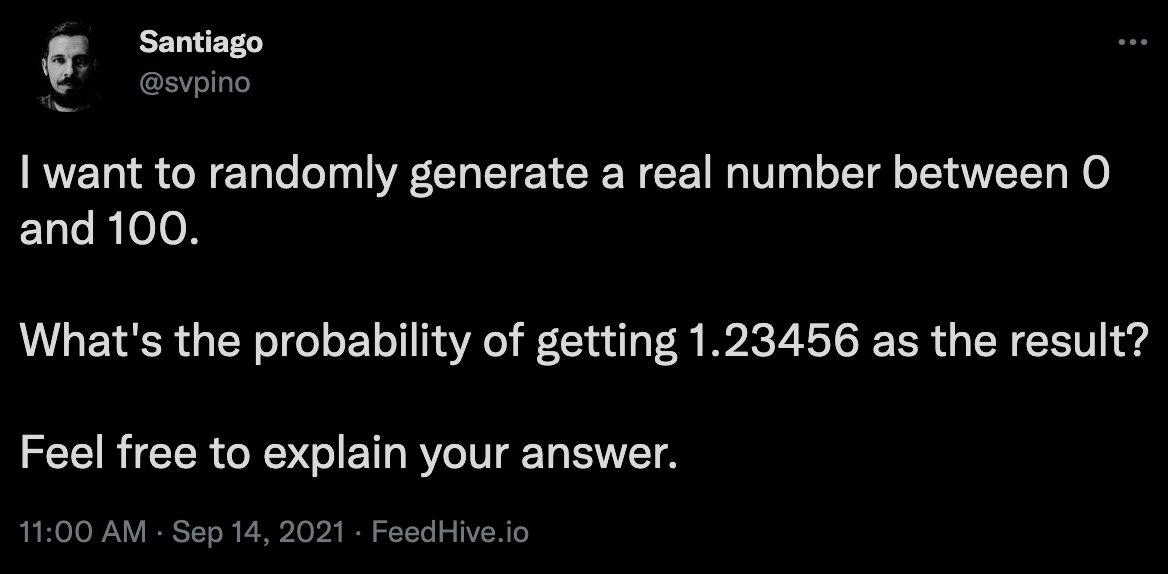
One issue I see with people applying for a job:
They struggle to highlight their experience in an effective way.
If you are trying to get a job as a Data Scientist or Machine Learning Engineer, here is something you can do.
↓
They struggle to highlight their experience in an effective way.
If you are trying to get a job as a Data Scientist or Machine Learning Engineer, here is something you can do.
↓
The first step is to stop thinking of "experience" exclusively as a synonym for employment history.
Experience is about all of the work you have done. It doesn't matter whether someone else paid for it.
If you know how to get things done, you should highlight it.
Experience is about all of the work you have done. It doesn't matter whether someone else paid for it.
If you know how to get things done, you should highlight it.
The second step is doing some inventory.
I'm sure you can find examples and exercises you've solved over the past few months.
They don't have to be end-to-end applications. They just need to showcase your knowledge and ability to make things work.
Collect them all.
I'm sure you can find examples and exercises you've solved over the past few months.
They don't have to be end-to-end applications. They just need to showcase your knowledge and ability to make things work.
Collect them all.
Curate all of these examples. Remove duplicates. Get rid of those that are either too simple or need too much context to be relevant.
Keep a shortlist with the examples that are relevant to the job you want. Each highlighting something unique and exciting.
Keep a shortlist with the examples that are relevant to the job you want. Each highlighting something unique and exciting.
Some people have mentioned that they don't have any code lying around.
If that's the case:
1. You aren't looking hard enough.
2. You indeed have not done anything.
If you are part of the second group, I'd recommend that you start building right away.
If that's the case:
1. You aren't looking hard enough.
2. You indeed have not done anything.
If you are part of the second group, I'd recommend that you start building right away.
You don't have to overthink this.
Something you can do: Take every exercise from the course you just finished, and create a notebook for each of them.
Document the code. Document the purpose of the example.
Something you can do: Take every exercise from the course you just finished, and create a notebook for each of them.
Document the code. Document the purpose of the example.
The final step is about presenting all of this work.
There are many different ways to accomplish this, but I enjoy @DeepnoteHQ's profiles.
Here is mine: deepnote.com/@svpino/.
Look at some of the few examples I have in there.
There are many different ways to accomplish this, but I enjoy @DeepnoteHQ's profiles.
Here is mine: deepnote.com/@svpino/.
Look at some of the few examples I have in there.

You could publish all of the work on GitHub, but @DeepnoteHQ gives you something that makes a huge difference:
You can run your code right there.
People don't need to set up or download anything. With Deepnote, you can run your entire portfolio right from the browser.
You can run your code right there.
People don't need to set up or download anything. With Deepnote, you can run your entire portfolio right from the browser.
As you learn and make progress in your career, build the habit of collecting your work in a single place.
Not only you'll be helping other people, but over time, you'll build an impressive profile that will be your presentation card for new opportunities.
Not only you'll be helping other people, but over time, you'll build an impressive profile that will be your presentation card for new opportunities.
As part of your resume, you can link to this portfolio of work.
Highlight some of the most relevant examples. Explain the reason you think they are relevant for the position.
Show, don't tell. This is the way you open doors.
Highlight some of the most relevant examples. Explain the reason you think they are relevant for the position.
Show, don't tell. This is the way you open doors.
Every week, I post 2 or 3 threads like this, breaking down machine learning concepts and giving you ideas on applying them in real-life situations.
You can find more of these at @svpino.
If you find this helpful, stay tuned: a lot more is coming.
You can find more of these at @svpino.
If you find this helpful, stay tuned: a lot more is coming.
Put together a collection of notebooks showing your different skills.
You can use projects you have worked on or develop different hypothetical situations that you solve in your notebooks.
You can use projects you have worked on or develop different hypothetical situations that you solve in your notebooks.
https://twitter.com/farye_ha/status/1440278341785841671?s=20
When in doubt about what to include in this portfolio, ask yourself the following question:
Does this piece help establish my credibility and experience?
Remember, you can spin and talk until your face turns blue, but nothing speaks more than showing your own work.
Does this piece help establish my credibility and experience?
Remember, you can spin and talk until your face turns blue, but nothing speaks more than showing your own work.
• • •
Missing some Tweet in this thread? You can try to
force a refresh







